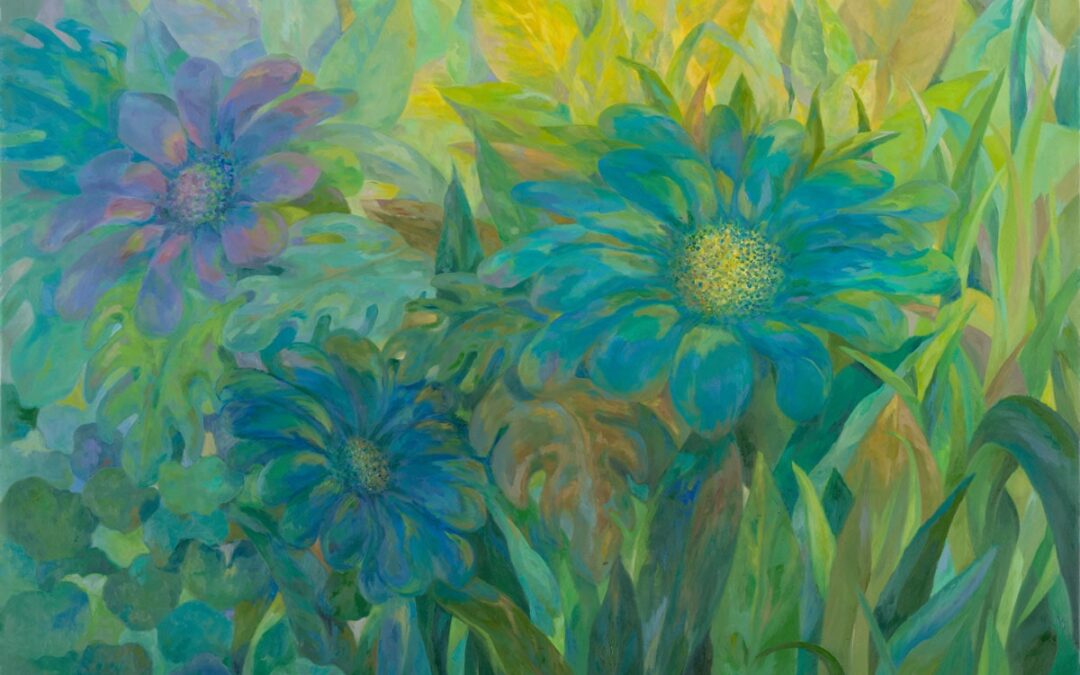Flowers have long been a source of artistic inspiration, symbolizing beauty, growth, and spiritual significance. In Judaica art, floral motifs hold deep meaning, often representing renewal, divine presence, and the connection between nature and faith. Moreover, throughout history, Jewish artists have incorporated flowers into their works to enhance themes of tradition, spirituality, and cultural identity.
One of the defining characteristics of Judaica art is its ability to merge symbolism with aesthetics. Flowers, in particular, serve as powerful visual elements that communicate spiritual and historical messages. In her paintings, Michal Shmuel depicts soft, tranquil hues or vibrant, expressive strokes to bring her floral imagery to life. Thereby elevating them beyond mere decoration.
The Tranquility of Cool Blue and Green Tones
Nature’s Dance Between Stillness and Motion features flowers in cool blue and green tones, evoking a sense of serenity and contemplation. These colors, often associated with water and sky, create a meditative atmosphere that reflects the spiritual depth of Judaica art. Here, flowers symbolize the continuity of Jewish heritage, much like the eternal cycle of nature. As well, the subdued palette fosters introspection, inviting viewers to connect with their faith on a deeper level.
Lily Flowers and the Reflection of Jerusalem
Another remarkable example of floral imagery in Judaica art is The Neshama of Jerusalem. In this painting, the lily flowers float in a pond, with the city of Jerusalem reflecting in the water. The lily, a flower often associated with purity and divine elegance, holds significant meaning in Jewish tradition. Its delicate form and luminous petals are in harmony with the softness of Jerusalem’s architecture distorted in the water’s mirrorlike surface. The reflection in the water serves as a metaphor for the spiritual essence of the city, reminding viewers of its sacred presence even in distant lands. This interplay between nature and holy sites exemplifies how Judaica art bridges the material and the divine.
A Blossoming Jerusalem: The City in Full Bloom
A painting of Jerusalem adorned with an array of colorful flowers celebrates the city’s vibrancy and historical richness. Flowers in every color burst across the foreground canvas, infusing the ancient stone pathways with life and movement. This depiction emphasizes the enduring spirit of Jerusalem, a place of resilience and renewal. The contrast of organic flowers which bloom only once a year with the city’s everlasting stone buildings highlights how Judaica art preserves and reinterprets history through an artistic lens. Flowers, with their colors, symbolize joy, and their yearly return symbolizes continuity. Moreover, they also embody the deep-rooted connection of the Jewish people to their homeland.
The Symbolism of the Almond Tree in Blossom in Judaica Art
The almond tree holds a special place in Jewish tradition, frequently appearing in Judaica art as a symbol of awakening and divine promise. Shmuel’s painting of an almond tree in full bloom captures the fleeting yet powerful nature of renewal. In biblical texts, the almond tree is associated with vigilance and the fulfillment of prophecy. Its early blossoms herald the arrival of spring, much like the promise of redemption in Jewish belief. Stories Beneath the Blossoms serve as a reminder of hope and perseverance that define the Jewish identity and culture.
Flowers in Judaica Art
Flowers play a profound role in Judaica art, serving as symbols of faith, history, and renewal. Through color, composition, and cultural meaning, floral motifs enhance the artistic expression of Jewish identity. Whether through a tranquil blue-toned painting, a reflection of Jerusalem in a lily pond, a vibrant cityscape in bloom, or the timeless elegance of an almond tree, flowers continue to inspire and elevate Judaica art. They remind us of the beauty inherent in tradition and the ever-present connection between nature and spirituality.

